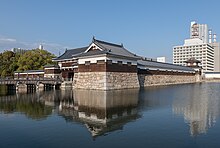Hiroshima Castle
| Hiroshima-jō | ||
|---|---|---|
|
Reconstruction of the main tower |
||
| Alternative name (s): | Carp Castle | |
| Creation time : | 1592–1599, reconstruction in 1958 | |
| Castle type : | Hirajiro (Lower Castle) | |
| Conservation status: | Reconstructed, serves as a history museum | |
| Standing position : |
Mōri clan (1592–1600), Fukushima Masanori (1600–1619), Asano clan (1619–1869), Japan (since 1869) |
|
| Construction: | Stone, wood, plaster (original); Concrete, steel, wood, stone, plaster (reconstruction) | |
| Place: | Hiroshima, Japan | |
| Geographical location | 34 ° 24 '10 " N , 132 ° 27' 32" E | |
|
|
||
The castle Hiroshima ( Japanese 広島城 , Hiroshima-jō ), sometimes Carp Castle ( 鯉城 , Rijo called) is a castle in Hiroshima in Japan . It was the seat of some daimyo (feudal lords) of the Han (fiefdom) of Hiroshima. The castle, originally built in the 1590s, was destroyed by the atomic bomb in 1945. The replica, built in 1958, now serves as a museum for the history of Hiroshima before World War II .
history
Mōri Terumoto , one of Toyotomi Hideyoshi's Council of Five Regents , laid the foundation stone for the construction of Hiroshima Castle in 1589 in the Otagawa Delta. At that time, Hiroshima city did not exist and the area was called Gokamura, five settlements . From 1591 Mōri ruled nine provinces from the castle, including large parts of today's prefectures Shimane , Yamaguchi , Tottori , Okayama and Hiroshima .
When construction of the castle began, Gokamura was renamed Hiroshima as a more evocative name seemed necessary. Hiro is from Ōe no Hiromoto , an ancestor of the Mōri family, and Shima from Fukushima Motonaga , who helped Mōri Terumoto choose the location for the castle. According to other accounts, the name Hiroshima , which literally means "wide island", is derived from the existence of numerous large islands in the nearby Otagawa Delta.
In the Battle of Sekigahara in 1600 Mōri was expelled from the castle and retired to Hagi in what is now Yamaguchi Prefecture . Fukushima Masanori became the new feudal lord of the Aki and Bingo provinces , which comprised the present-day Hiroshima Prefecture and the castle. In order to limit the daimyō's power and influence and for fear of being overthrown by them, the new Tokugawa shōgunate only permitted construction work on castles with the approval of Edo . When Fukushima had the castle repaired after a flood in 1619, he was replaced by Asano Nagaakira and exiled to Kawanakajima in what is now Nagano Prefecture .
From 1619 until the end of the feudal system during the Meiji Restoration in 1869, the Asano clan , who had the above family sign , two crossed hawk feathers, controlled the provinces of Aki and Bingo.
After the Meiji Restoration, the castle served as a military facility and during the First Sino-Japanese War, 1894 to 1895, the Imperial General Staff took up a position there. The foundations of some outbuildings within a few hundred meters of the main tower of the castle still exist today.
The castle was destroyed by the atomic bomb on August 6, 1945. The reconstruction of the tower, mainly made of concrete, was completed in 1958.
Today a museum on the history of Hiroshima before the Second World War is set up in the castle .
Daimyō from Hiroshima
The dates indicate when the feudal lord lived in Hiroshima Castle, not when he lived. All feudal lords after Asano Nagaakira could also enjoy a travel income of 426,500 koku .
- Mōri Terumoto (1591–1600), 1,120,000 koku
- Fukushima Masanori (1600-1619), 498,223 koku
- Asano Nagaakira (1619-1632), 426,500 koku
- Asano Mitsuakira (1632–1672)
- Asano Tsunaakira (1672–1673)
- Asano Tsunanaga (1673–1708)
- Asano Yoshinaga (1708-1752)
- Asano Munetsune (1752–1763)
- Asano Shigeakira (1763-1799)
- Asano Narikata (1799-1830)
- Asano Naritaka (1831-1858)
- Asano Yoshiteru (1858)
- Asano Nagamichi (1858–1869)
- Asano Nagakoto (1869)
Building description
The castle was originally made of wood, mostly pine, with wings to the east and south. It was completed sometime between 1592 and 1599 and was declared a national treasure in 1931 . Today's castle only has the main tower (Tenshu), which was mainly made of reinforced concrete. With its five floors, it has a height of 26.6 meters above the stone plinth, which in turn protrudes 12.4 meters from the ground. In recent years, a gate and a tower (yagura) of the kennel wall (ninomaru) have been reconstructed from wood.
Hiroshima Castle is a good example of a low castle . Alongside the Otagawa River (now Hongawa), which was a natural barrier to the west, the castle once had three concentric moats . The two outer moats were filled in in the late 19th and early 20th centuries and large parts of the area that was once inside the castle complex became a modern urban area through the construction of houses, schools, office buildings and shops. Some outbuildings and towers of the castle were rebuilt within the inner moat after their destruction in 1945, including a Shinto shrine , the Hiroshima Gokoku Shrine , in 1965.
Also inside the Honmaru is a concrete bunker where the first radio broadcast from Hiroshima took place after the atomic bomb was dropped.
literature
- Marianne Mehling (Ed.): Knaurs Culture Guide in Color - Japan. Droemer Knaur, Munich 1989, ISBN 3-426-26250-9 , p. 48.
- Morton S. Schmorleitz: Castles in Japan. Charles E. Tuttle Co., Tokyo 1974, ISBN 978-0-8048-1102-6 , p. 145 ( digitized in the Internet Archive , English).
Web links
- Hiroshima Castle Official Website (Japanese, English)
- Hiroshima Castle . In: Hiroshima-Navi.or.jp
- Hiroshima Castle . In: Reise-Japan.de
- Hiroshima Castle . In: Japan-Infos.de



